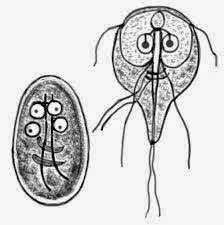1. Virus:
Is the highest cause of acute diarrhea in children (70-80%). Some types of viruses that cause acute diarrhea:
- Rotavirus serotypes 1,2,8, and 9: in humans. Serotype 3 and 4 were found in animals and humans. And serotypes 5,6, and 7 were found only in animals.
- Norwalk virus: present in all ages, generally due to food borne or water borne transmission, and the transmission can also occur person to person.
- Astrovirus, found in children and adults
- Adenovirus (type 40, 41)
- Small bowel structured viruses
- Cytomegalovirus
2 Bacteria:
- Enterotoxigenic E. coli (ETEC). Have two important virulence factor is a factor that causes bacterial colonization is attached to the enterocytes of the small intestine and enterotoxin (heat labile (HL) and heat stabile (ST) which causes the secretion of fluid and electrolytes that produce watery diarrhea. ETEC causes no damage to brush border or invade the mucosa.
- Enterophatogenic E. coli (EPEC). The mechanism of diarrhea is not clear. Found the process of attachment of EPEC to intestinal epithelial damage of membrane micro-villi which would disturb the surface absorption and disaccharidase activity.
- Enteroaggregative E. coli (EAggEC). These bacteria are strongly attached to the mucosa of the small intestine and causes typical morphological changes. How does the mechanism of the onset of diarrhea is still unclear, but it may play a role cytotoxins.
- Enteroinvasive E. coli (EIEC). In serologic and biochemical similar to Shigella. Such as Shigella, EIEC penetrate and multiply within colonic epithelial cells.
- Enterohemorrhagic E. coli (EHEC). EHEC producing verocytotoxin (VT) 1 and 2, which is also called Shiga-like toxin that causes diffuse edema and bleeding in the colon. In children often progress to hemolytic-uremic syndrome.
- Shigella spp. Shigella invade and multiply within colonic epithelial cells, causing cell death and the onset of mucosal ulceration. Shigella rarely enter into the bloodstream. Virulence factors including: smooth cell-wall lipopolysaccharide antigen and endotoxin activity has helped the process of invasion and toxin (Shiga toxin and Shiga-like toxin) that are cytotoxic and neurotoxic and may cause watery diarrhea.
- Campylobacter jejuni (Helicobacter jejuni). Humans become infected through direct contact with animals (birds, dogs, cats, sheep and pigs) or with animal feces through contaminated food such as chicken and water. Sometimes the infection can be spread through direct person to person contact. C.jejuni may cause diarrhea by invasion into the small intestine and colon great.There 2 types of toxin produced, the heat-labile cytotoxin and enterotoxin. Histopathological changes that occur similar to the process of ulcerative colitis.
- Vibrio cholerae 01 and V.cholerae 0139. water or food contaminated with this bacteria will transmit cholera. Through person to person transmission is rare.
- V.cholerae attached and proliferated on the mucosa of the small intestine and produces an enterotoxin that causes diarrhea. Cholera toxin is very similar to the heat-labile toxin (LT) of ETEC. The last discovery of the existence of other enterotoxin that has its own characteristics, such as the accessory cholera enterotoxin (ACE) and zonular occludens toxin (ZOT). Both of these toxins cause fluid secretion into the intestinal lumen.
- Salmonella (non-typhoid). Salmonella can invade intestinal epithelial cells. Produced enterotoxin causing diarrhea. If there is damage that causes mucosal ulcers, bloody diarrhea will occur.
3. Protozoa:
- Giardia lamblia. This parasite infects the small intestine. Patogensis mechanism remains unclear, but is believed to affect the absorption and metabolism of bile acids. Transmission through the fecal-oral route. Host-parasite interactions is affected by age, nutritional status, endemicity, and immune status. Areas with high endemicity, giardiasis can be asymptomatic, chronic, persistent diarrhea with or without malabsorption. In areas with low endemicity, outbreaks can occur within 5-8 days after exposure to the manifestation of acute diarrhea is accompanied by nausea, epigastric pain and anorexia. Sometimes encountered malabsorption with faty stools, abdominal pain and bloated.
- Entamoeba histolytica. Dysentery amoeba prevalence varies, but its spread throughout the world. The incidence increases with age, and teranak in adult males. Approximately 90% of asymptomatic infections caused by non-pathogenic E.histolytica (E.dispar). Symptomatic amebiasis can be mild and persistent diarrhea to fulminant dysentery.
- Cryptosporidium. In developing countries, cryptosporidiosis 5-15% of cases of diarrhea in children. The infection is usually symptomatic and asymptomatic infants in older children and adults. Clinical symptoms of acute diarrhea with watery type of diarrhea, usually mild and self-limited. In people with impaired immune systems such as AIDS patients, cryptosporidiosis is a reemerging disease with more severe diarrhea and resistant to some antibiotics.
- Microsporidium spp
- Isospora belli
- Cyclospora cayatanensis
4. Helminths:
- Strongyloides stercoralis. Abnormalities in intestinal mucosa caused by adult worms and larvae, causing diarrhea.
- Schistosoma spp. The blood worms cause abnormalities in various organs including the intestinal manifestations, including diarrhea and intestinal bleeding.
- Capilaria philippinensis. This worm is found in the small intestine, especially jejunu, causing inflammation and villous atrophy with clinical symptoms of watery diarrhea and abdominal pain.
- Trichuris trichuria. Adult worms live in the colon, caecum, and appendix. Severe infections can cause bloody diarrhea and abdominal pain.




